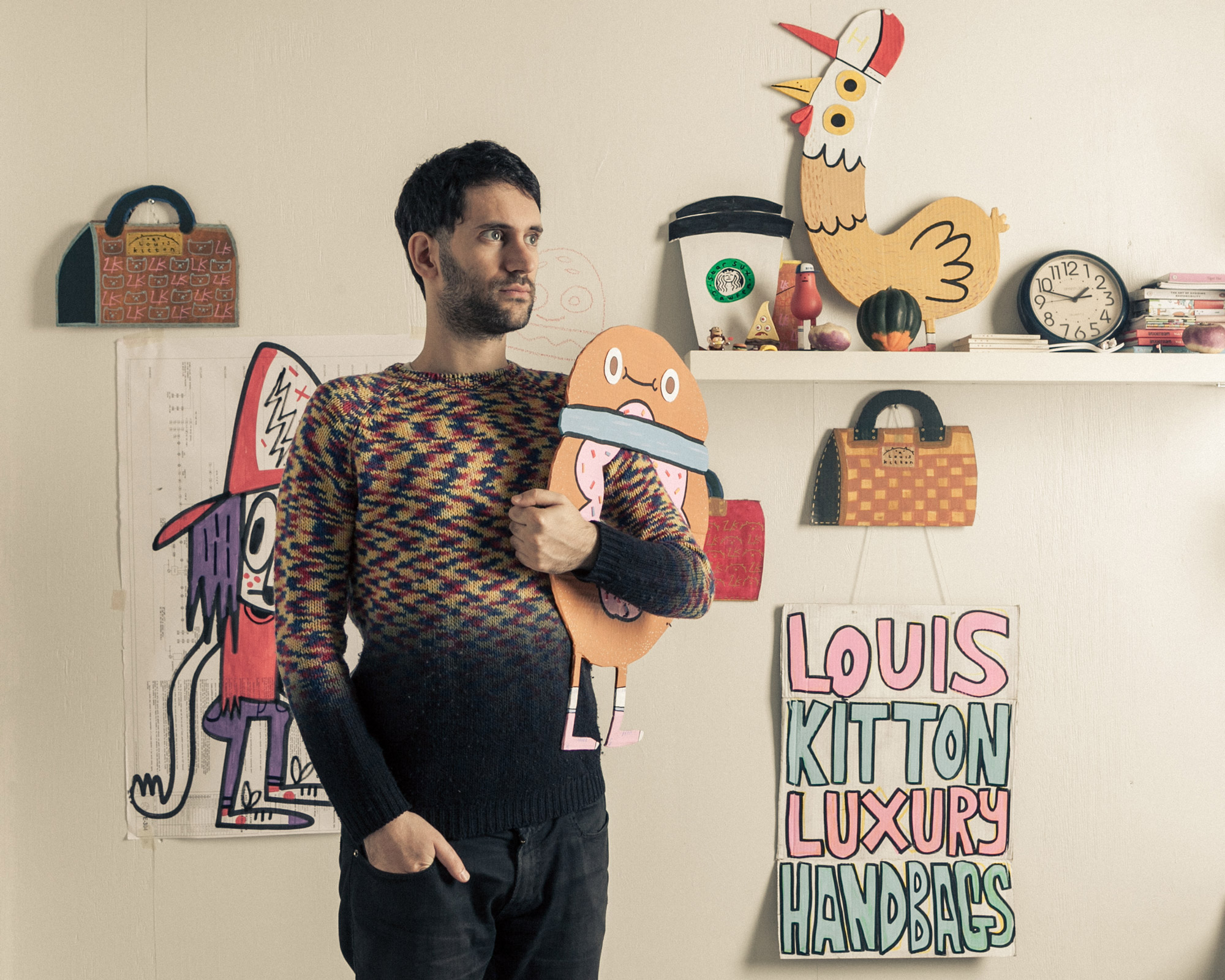
- Interview by Ryan & Tina Essmaker April 22, 2014
- Photo by Catalina Kulczar
Jon Burgerman
- artist
- illustrator
Jon Burgerman is a UK born, New York City-based artist, who is well-known for his doodle art style. He studied Fine Art at Nottingham Trent University and graduated in 2001, after which he began developing his now pervasive and instantly recognizable aesthetic that exists across a multitude of forms. Jon performs, speaks, and teaches internationally, and has collaborated with well-known brands like Nike, Sony, Puma, Pepsi, Levi’s, and MTV.
Interview
Describe your path to what you’re doing now.
I was born in Birmingham, which is in the middle of England. Have you been to the UK?
Sadly, no.
Well, it’s awaiting you. Anyway, I was born in the middle of the UK. I’m a Midlander and a middle child, which puts me slap-bang in the dead center—a bullseye from the bullring as we say in Birmingham.
After school, I stayed in Birmingham and studied art for a foundation year. I don’t know if you have that in the US, but foundation is a year of study before going to university. I messed around with all manner of crazy stuff so that I’d have a better idea of what art course I wanted to do at university. Midway through foundation, I had to specialize. I was torn between graphic design and fine art; I wanted to do both, but the tutors wouldn’t let me. I chose graphic design and did that for a couple of weeks, but found it a bit stifling. I sat at a desk, designing packaging for an imaginary toothpaste brand; then I’d walk by the fine art studio and there were people running around, girls screaming, tearing paper, splashing paint. I decided then to leave graphics and study fine art with all the other weirdos.
From there, I went to university in Nottingham—not Notting Hill. (all laughing) I had planned to go to London, but my application form was lost in the mail. All of my friends who were studying art were going off to their interviews, and I thought, “Oh, where’s my interview? I haven’t gotten one yet.” My application never turned up, and I received a letter from the Universities and Colleges Admissions Service (UCAS) stating that my application didn’t get processed and I was facing a year of waiting. My second choice was Nottingham, so my tutor phoned up the university and explained the situation; they said, “Okay, if he comes tomorrow, he can be the very last person we interview for the next academic year.” I did that and they offered me a spot.
Nottingham had a really good art program, and I didn’t have to specialize. During one term, I could take sculpture and, for the next term, I could study painting. In a lot of traditional art programs, you specialize in one thing. In a funny way, foundation and university suited me because I played around with lots of different media, and that set forth the blueprint for my professional career thus far.
For example, one of the courses I took taught me how to make a website; not many of my peers took the class. Admittedly, I took it reluctantly, but thought, eh, maybe this Internet thing will be big in the future. By the time I left university, almost everyone had a computer and email address; a year or two after graduation, people started getting broadband; now, it’s the world as we know it. It was interesting to become a grown-up—well, a sort of grown up—at that point of change.
Tina: What did you do after school?
Well, I left university with a lot of debt, which is quite common. I didn’t want to move home, and I couldn’t afford to live anywhere else, so I stayed in Nottingham. At that point, I had a part-time job doing art-working, which allowed me to learn how to use the computer. I lied when I went to the job interview; they asked, “Do you know how to use Quark Express? Do you know how to use a Macintosh?” I replied, “Yes, I know all those things you speak of,” and then I ran to the library, went online, and printed off how-to guides. I worked in a small office, and when my boss left the room, I’d open a drawer, look down at my notes, and quickly refresh myself on how to draw a text box or create a new file.
Tina: What was your job title there?
“Designer or the person that knows how to use the Mac.” It wasn’t strictly design, but the company produced packaging for shops and businesses. We’d get artwork assets from a shop or company and I’d lay it out, burn it onto a CD, and send the CD to the Far East. Of course, there’d be a spelling mistake on the file and, two months later, a giant container on a boat would dock into the UK, the container would come to the warehouse, someone would open the box of 10,000 bags, and they would find that their address was spelled wrong—and that would be completely my fault. That job taught me lots of things; one was attention to detail, and the other was that I didn’t want to have a proper job.
I worked part-time, and when I wasn’t at work, I made my own stuff and traveled. There was a graphic design firm in the office below ours, and I used to pop in every now and then to say hello. One day, on a Friday afternoon, they beckoned me in and said, “Oh, Jon, you paint and draw stuff, don’t you?” I replied, “Yeah.” They were working on an album cover, but the client didn’t like any of the work. They told me to come back on Monday with some drawings and maybe they’d pick mine. I spent all night drawing stuff and had no idea what I was doing. I went back in with sketches and they picked one. The next week I painted it; the following week it was photographed; and a month later, it was in records shops. Remember those?
Yes. (laughing)
It was for a good album, too. It was Charles Webster’s first album under his own name, Born on the 24th of July. It was significant because the album was reviewed by national press, printing my cover artwork each time. I got paid almost nothing, but it was a total thrill. From there, I honestly thought I’d be able to leave my job and say, “See ya later guys; I’m going to go and be a big star of the album cover world.” It didn’t quite happen that way, but it started the ball rolling. My name was printed on the album credits and I had a website because I had learned how to build one at university. People started getting in touch with me to do album and EP covers.
Simultaneously, I had been traveling and putting stickers places; I had no idea it was a thing. When I was in university, I had made stickers because I hated carrying around a big portfolio. I used to make little books, stickers, anything I could fit in my pockets. I’d give them to people and stick them places. Sometimes I’d go to London and stick them there, but I didn’t realize there was a whole sticker scene. Out of the blue, I got an email from someone who was making a street art sticker book called Stick ’Em Up; they wanted to include me in it. Through that, I met others who were proper sticker and street art people. It opened a window into a new scene that I didn’t have access to before.
An ad agency saw that book and commissioned me to do some work for Levi’s. I took the call from the art director while I was at my day job. He told me what they would pay me for artwork and then mentioned usage. I asked, “What the hell is usage?” He replied, “We have to pay you again to use the work.” When I got done writing down the numbers on my notepad, I thought, “Okay, I’m leaving my job.” I handed in my notice and that was it. With that one job for Levi’s, I got paid as much as I would have gotten paid working part-time for a whole year. Who would’ve known I could do crappy little drawings and people would pay me? It blew my mind.
I didn’t spend any of the money from that job; I lived off of it instead. I still lived like a pauper student, eating beans out of a tin. I’m glad I did that because, for the next year, I only got little jobs here and there. (laughing) I used that time to make a new website, travel around the UK, make more stickers and prints, and get involved in exhibitions. That was a good lesson: money buys time, and that’s the best thing it can buy you. It bought me time to not have to go to work for someone else. Eventually, I got commissioned to do other bits and bobs.
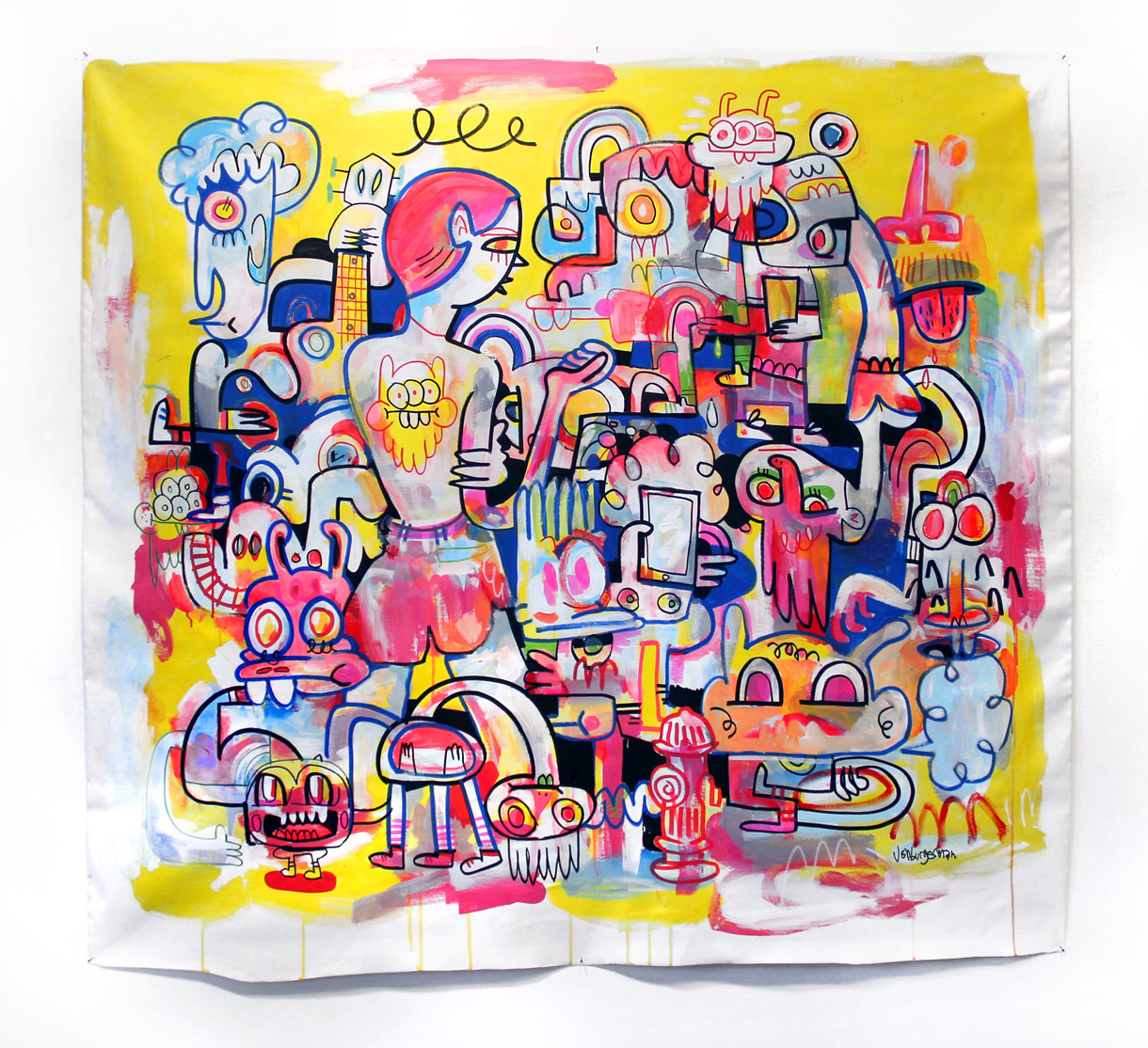
“My older brother is a solicitor and my younger brother works for the government as an economist. For me, it was risky even thinking about getting a job in graphic design…no one wanted me to be an artist.”
Tina: What brought you to the US?
I wanted to be a stranger and, in an act of self sabotage, start all over again.
When I started traveling a lot, I found that I could make my work anywhere. If I had a sketchbook, pen, USB scanner, and a laptop, then I was set. I’d go to exhibitions with no work, and I’d stay in the gallery for a month, make all my work in the space, and that would be the exhibition. You adapt to those situations; sometimes limitations help you create new stuff. I asked myself, “If I can work anywhere, then why am I here?” Nottingham was a great incubation, but after a while, I decided I needed to be somewhere else. I felt too comfortable where I was, so I started telling everybody that I was going to leave, and no one stopped me. No one said, “No, don’t go! We’ll miss you.” Really, I think it was a cry for attention. (laughing)
Meanwhile, I had started to come to New York for exhibitions and had made friends here. I drew up a shortlist of places I’d like to live and New York was at the top of the list. I thought I should go for it because it was the most difficult one. I went to see a lawyer and told her I’d like to live in New York. She recommended that I get an O–1 visa, which is for an “alien with extraordinary ability.” I had to prove that what I do is special to me and unique in my field, so that I’m not taking a job away from anyone. It was a fairly straightforward process. I was approved and moved here three and a half years ago.
Moving to New York was the end of chapter one of my adult life. I had a big studio in Nottingham; I had an employee; in 2008, a 300-page monograph of my work was published; I had built up all this stuff, but I wanted to hit refresh. When I left, I got rid of almost all of my possessions. I had a queue of art students coming to my apartment for pens and paper that I gave away. I arrived in New York with two suitcases and nowhere to live. I was proud of doing it all myself and for no real good reason; I kept telling people, “Now I am a man!”
Chapter two of my life has been about working in a slightly different way and not feeling tied to being the kind of artist people think or say I am.
Ryan: What’s different about what you’re working on now?
Of course there are similarities. When I moved here, my friend and I had a band, Anxieteam, so I was doing performances. We made silly props out of cardboard and I learned to play an instrument. So I began singing in front of people and dancing on stage. It’s frightening to start dancing and singing in front of a crowd of people who are neither singing or dancing. Quite often, they were just standing there, arms folded, wondering who on Earth this band playing songs about salads was. It was super scary, but after a while it was cleansing, too. I felt like if I survived doing that, then there was not much else to be scared of.
At the same time, I started making videos, drawing stuff from life, and doing more talks and lectures. There’s too much I want to say and do and see and feel and experiment with. There’s a real joy in not knowing what the hell you’re doing; there’s a joy in amateurism.
For example, a couple years ago, I was invited to do life drawing at the Art Director’s Club for a charity event. I thought, “Hmm, okay, I don’t really do that, but if you want me to come, I will.” They had burlesque dancers, pythons, and trapeze artists, and I had to draw them. Everyone around me had graphite sticks and did fashion illustrations; I had my chunky marker pens. We had to pin our drawings on the walls so people could buy them. My drawings looked all wrong, but I was ok with it—if you can’t be good, be different. My work stood out a mile and people thought it was cool. Following that, I decided I was going to draw more figurative things, and from that, I started my Tumblr girl project.
“There’s too much I want to say and do and see and feel and experiment with. There’s a real joy in not knowing what the hell you’re doing; there’s a joy in amateurism.”
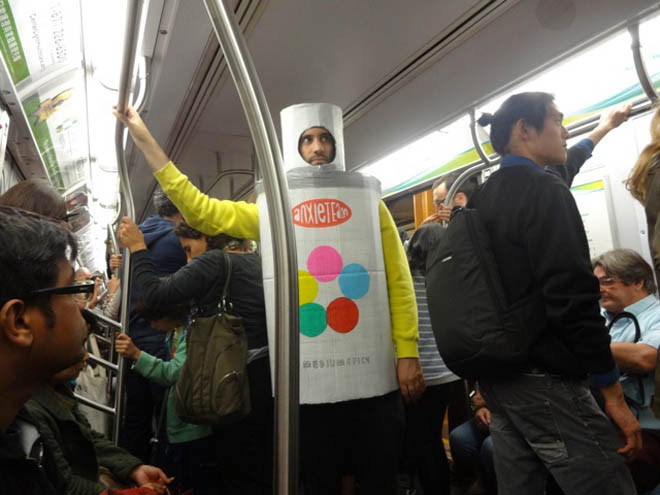
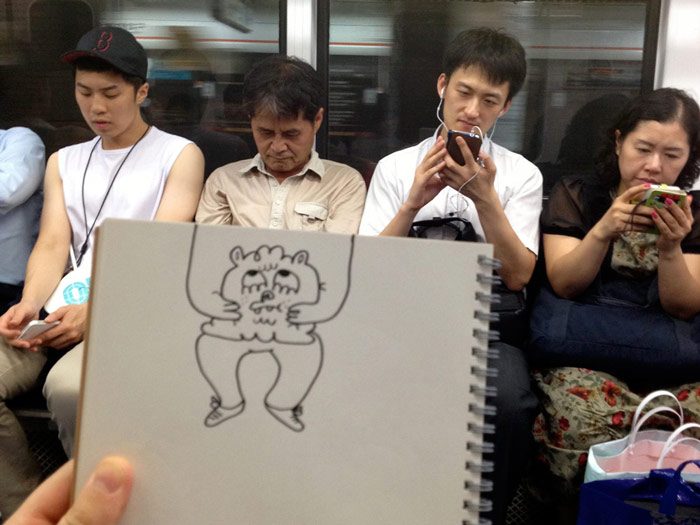
Going back to childhood, was creativity a part of your life?
For me, it was always going to be art. I was very lucky because, before my younger brother was born, we had a spare room that was an art studio; I had my first studio up until the age of six, which was brilliant! My mom and I would go in the studio and I’d have a big sheet of colored paper and oil pastels; I have a strong memory of drawing orange trees. Then my brother came along and ruined it all.
My mom actually studied art when she was younger. She isn’t an artist and she wasn’t an artist, but she had gone to art school until she met my dad. She’s very talented, but she stopped; it’s a shame. Some of her paintings were hung on our walls. Apart from my mom, no one did art.
Before I was born, my dad was a freelance journalist. I have vague memories of seeing newspaper clippings of his sports reports and the news stories he had written. At one point, he owned a video shop, so there was a period when I watched a lot of movies. Then he got a job being a sales rep for a film company, which involved him being away a lot, but he’d come home with a trunk full of merchandise: posters, stickers, mugs, key rings. I’d gorge myself on all those things; maybe it’s no surprise that I’ve gone on to make a lot of similar stuff.
There was the DNA of creativity, but, unfortunately, my parents had already succumbed to a life of towing the line and getting a job; I guess that’s what happens when you have three kids and live in an urban neighborhood in a big city and have to do what you need to do. It was a fine upbringing, though, and I liked growing up in the nondigital world.
My older brother is a solicitor and my younger brother works for the government as an economist. For me, it was risky even thinking about getting a job in graphic design. My mom never encouraged me to do art for a living, and no one wanted me to be an artist. I remember one time when my mom picked me up from school and I told her, “I think I’m going to do fine art instead of graphic design.” She replied, “No, you shouldn’t do that. You’ll never get a job. It’s a bad idea.”
Did you have an “Aha!” moment when you realized that art was something you could do for a living?
I always knew I’d draw or make art, but I never realized it was something I could do for a living until I got the Levi’s job. In school, I looked forward to art and it was the one subject I was good at. Also, I’m very, very lazy, and I didn’t have to try very hard at art and everyone still seemed to be pleased with me. My friends said to me, “Oh, you’re going to be an artist when you’re older,” because I could sort of draw, but I didn’t know what being an artist meant.
Early on, when I started to get interviewed and people asked what I did, I answered, “I’m a doodler.” That was a means of saying I make stuff. Obviously I research and hone my skills and concentrate, but the term doodling stuck. I have kids who email me to say they’re doodle artists too. When I say doodling, I don’t mean the way it looks; I mean the way it’s been executed. I have the idea, work out what it is, and make it all at once. The closest word I can think of to describe that is doodling. That’s how I make a lot of my drawings; I have a rough idea, but when I start, it changes and adapts. That’s how I come up with conceptual ideas, too; I consider the idea itself to be a doodle. The important thing is to be open to it.
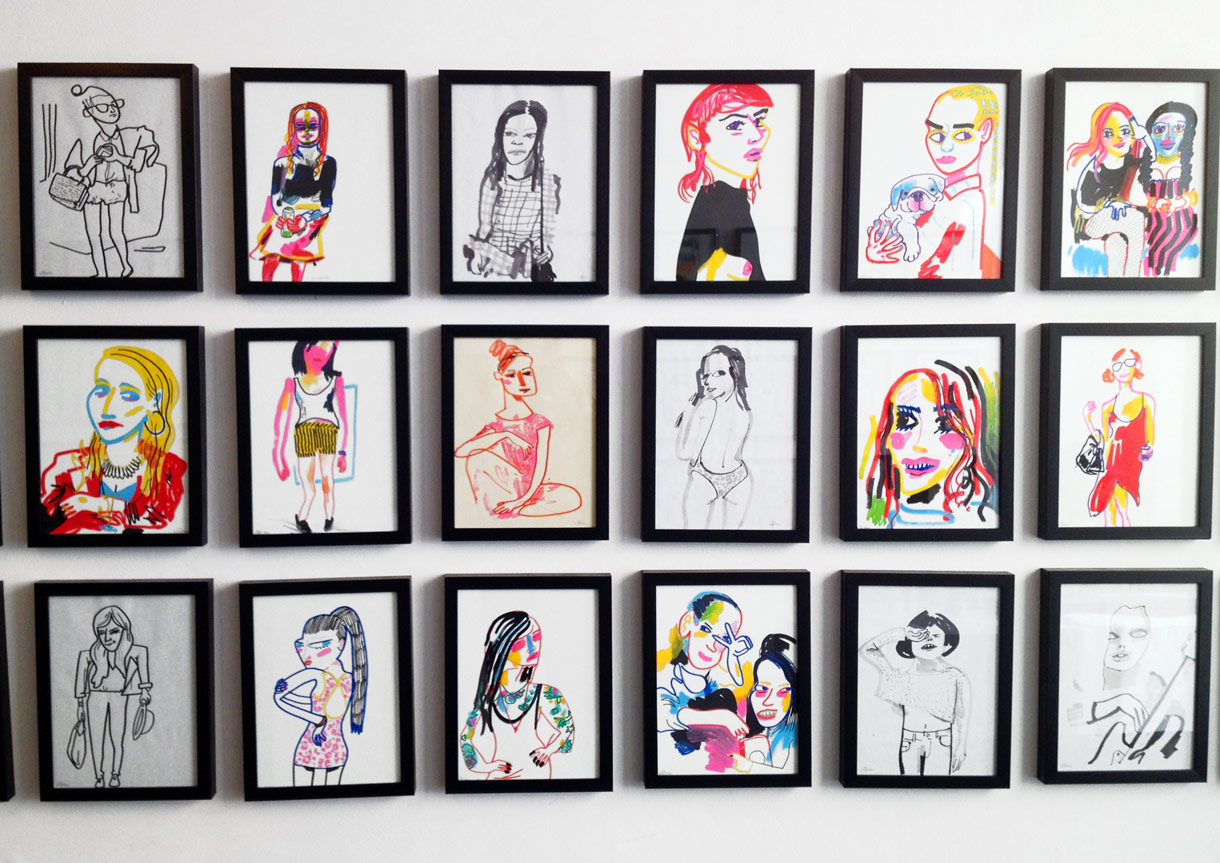
“There’s no substitute for the enthusiasm and joy of making the things you want to make…if you follow the thing you really want to do and work hard at it, you’ll find your place in that world, and maybe work will come to you. You’re more likely to get on when your heart is into it—there’s no other way to make creative work.”
Have you had any mentors along the way?
My foundation teacher, Ted Allen, was a brilliant guy. He said something to me that I still think about: “You should never follow the trends. You can’t copy anything. If something is popular, there’s no point in trying to join in. When you do that, you’ll always be behind, following in the footsteps of others. The only thing you can do as an artist is make your own work and, if you’re lucky, eventually the interest will swing around to you.” That’s what I did. That advice and keeping a sketchbook are the two things I remember from school. Other than that, I haven’t really had a mentor. I would love one, though.
Have you taken any big risks, aside from moving to New York?
I think throwing away my old life and moving over here was a big risk—how many more big risks do you want? Trying to be an artist is also quite risky. Trying to break out and do other types of work because I want to feels risky, even though, in the grand scheme of things, it’s not risky, especially in New York where almost everything is acceptable.
Were your friends and family supportive when you moved to New York?
There was no resistance from anyone. I wanted people to tell me not to go. I wanted someone, anyone, to cry! There were no tears. I had a good time in Nottingham, and I had some good friends there, but people had started moving. I have a small business based there and my business partner and ex-boss, Tony, had become a good friend. He and my younger brother were the saddest about me moving, and I was sad about no longer being able to see them. The people and city had been good to me; a local paper once called me “a son of Nottingham.” They had supported me, but there was more I wanted to do.
Do you feel a responsibility to contribute to something bigger than yourself?
Not really. For many people, it’s enough to look after themselves and their families. Where possible, I want to do good and give back and all those nice, lovely things that people say they want to do. I don’t feel like I owe anyone that, but I do think that if you can do good, then you probably should. Humans have a responsibility to take care of themselves and be most excellent to others, and to not piss off those around them—by that I mean the world around them.
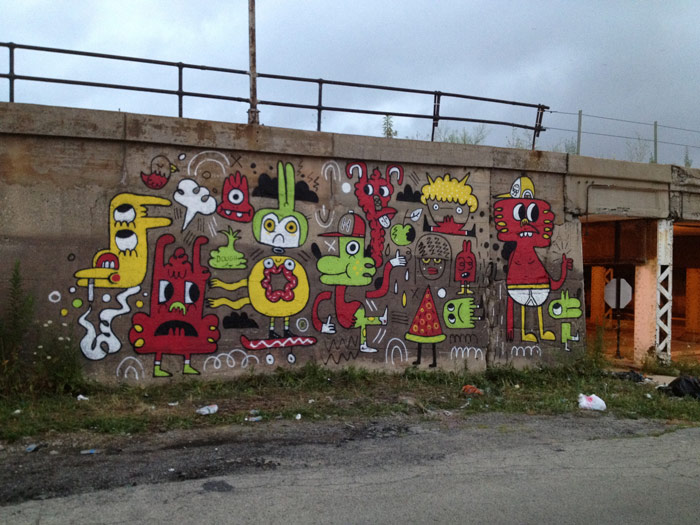
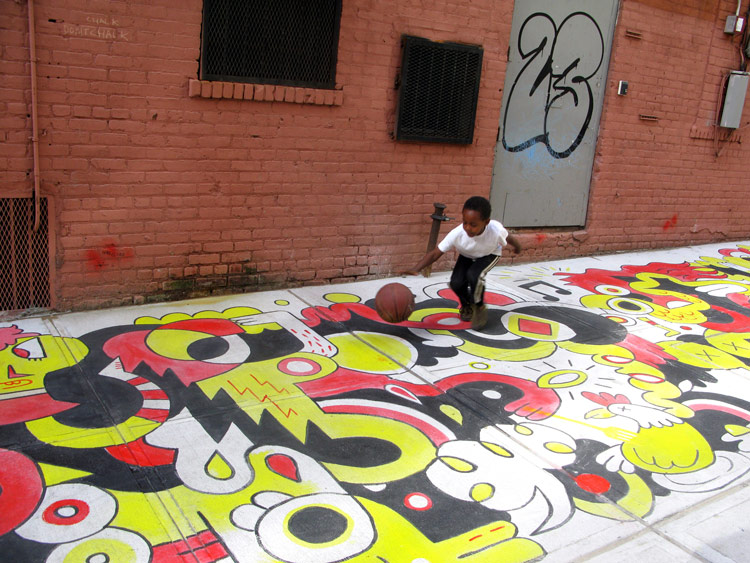
Are you creatively satisfied?
I’m satisfied that I get to make stuff. I’m not stacking shelves or working a horrible job without opportunities. I’m grateful and privileged to have options and to be making art some of the time—not all of the time, because there are things I have to do that no one thinks about, like admin stuff, meetings, taxes, and buying brightly colored cardigans. There’s no other job I’d rather be doing.
But am I making stuff and saying, “Yup, that’s perfect”? No. Not once. I’ve never made anything and thought, “That’s just perfect. Done. Encase it in amber so in 65 million years someone can genetically create a theme park out of it.” Never! I have these boxing gloves of hands and I’m trying to hold a crayon and scribble, and it’s like running in a dream; I’m trying to run, but I move slowly, too slowly. I aspire to the unreachable goodness of all my art heroes and the ridiculous benchmarks that I hold myself up against. I guess that if you were satisfied, you’d light a cigar and not get out of bed for a week. That would be a problem. What are you going to do tomorrow if you’ve already achieved it?
What advice would you give to a young person, or anyone, starting out in art?
I’d say be open to stuff. You might start out wanting to be this kind of artist or designer, but follow your interests. If you find something interesting, even if it’s not what you started doing or are trained for, it doesn’t matter. I think you should follow it. There’s no substitute for the enthusiasm and joy of making the things you want to make. You only live once. Honestly, if you follow the thing you really want to do and work hard at it, you’ll find your place in that world, and maybe work will come to you. You’re more likely to get on when your heart is into it—there’s no other way to make creative work.
The other advice is just do it—I mean, just doodle it. There are always obstacles and people look for excuses. When you’re young, you have nothing to lose; you’re supposed to be scraping by. That’s the best time to be poor because you don’t need to eat three meals a day and you can survive on eating junk food because you have a great metabolism. Things will be much harder when you’re in your mid–30s and have responsibilities, cynicism, and a dodgy knee.
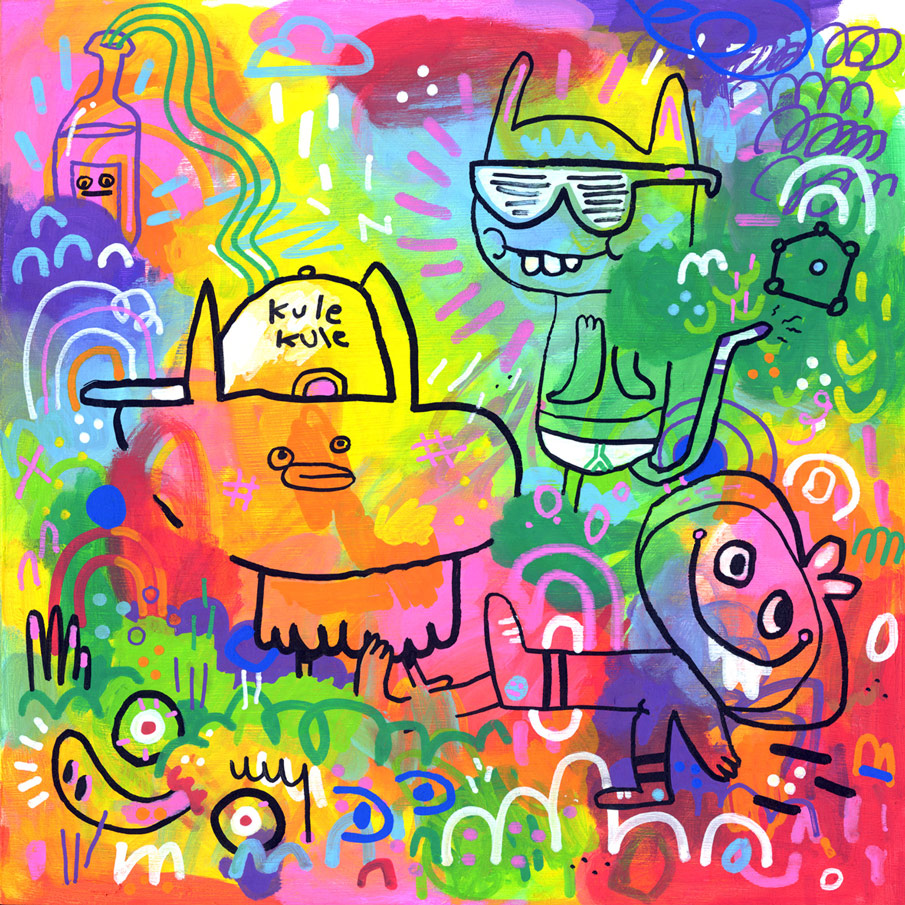
“…just do it—I mean, just doodle it. There are always obstacles and people look for excuses. When you’re young, you have nothing to lose; you’re supposed to be scraping by…Things will be much harder when you’re in your mid–30s and have responsibilities, cynicism, and a dodgy knee.”
Tina: If you wait until there are no obstacles, you will never do it.
And don’t wait to be asked, either. If you want to make an album cover, make one, even if no one asks you to; make one for an imaginary band or a band you love. Just make something. There are so many tools and platforms to show your work now. There’s no excuse.
Another thing I’ve learned is that people are the conduit to everything. Nothing happens without people. No matter who you are, you need other people. You need to go talk to others, chat with them, laugh with them, have a drink with them. You need to be out there, meeting people, even more so now that our default is digital interaction.
That’s good advice. You’re here in New York now. How does living here impact your creativity or work?
It’s been brilliant. I’ve met people, eaten lots of foods, been to exhibitions, openings, and shows. Work-wise, I’ve done more of a variety of stuff since being here. For example, the subway series, Head Shots, couldn’t have happened or had the same impact somewhere else, or maybe I wouldn’t have had the balls to do it.
I like the buildings and neighborhoods, but I’m a people watcher. Being surrounded by wacky people, whether they’re creative or not, is amazing. I love the people of New York, but less so when squashed in a subway car with them all. If you want weirdos and characters, New York is the epicenter. It’s incredible!
Friends I’ve made all over the world come to New York, and I get to see them. It’s a revolving door here, and the negative side of that is that I never feel settled. It feels temporary and transient. Every year, I’m crying because a friend is moving away, but a month later, I have a new best friend. In a way, I think it’s good. I’ve not come here to settle down and get all snuggly, unless there’s another polar vortex. It’s a kick up the backside to be in the thick of it.
Is it important to you to be part of a creative community of people?
I didn’t realize that it was, but it is. I’ve always felt like I’m a bit of an outsider, which is the good thing about New York: it’s where all the outsiders go to be together. I now have a studio at The Invisible Dog in Brooklyn, but even before that, I met more people doing things like me. I’ve been able to dip in and out of all these amazing communities. I still don’t belong to just one tribe, but having any kind of community is a powerful and important thing. We should encourage the building, cementing, and thriving of communities. That’s how people meet, talk, share ideas and problems, and get things off their chests; that’s what we need to do as human beings. We need to connect with real people and be open and honest. That’s the only way to navigate through life. It’s immensely powerful and important because we’re social beasts.
“Sometimes when I leave the studio and there is a shitload of work to do, I feel anxious. But you know what? That email will wait until tomorrow morning because, one, I want to live more and, two, it’s important to feed that inspiration, to get away from the screen and see and do stuff.”
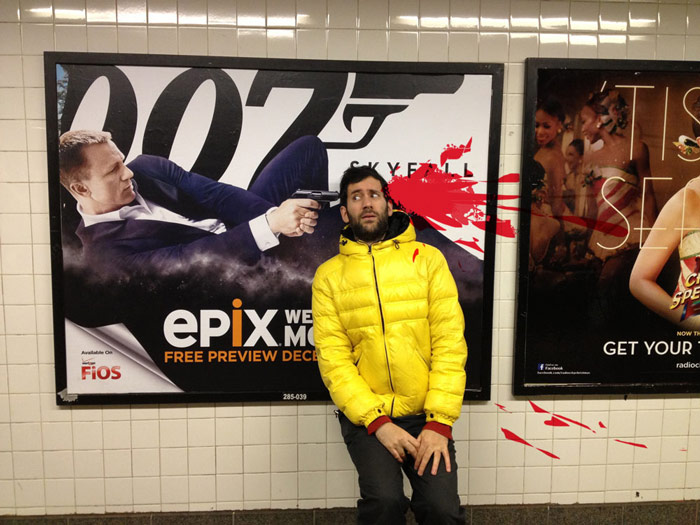
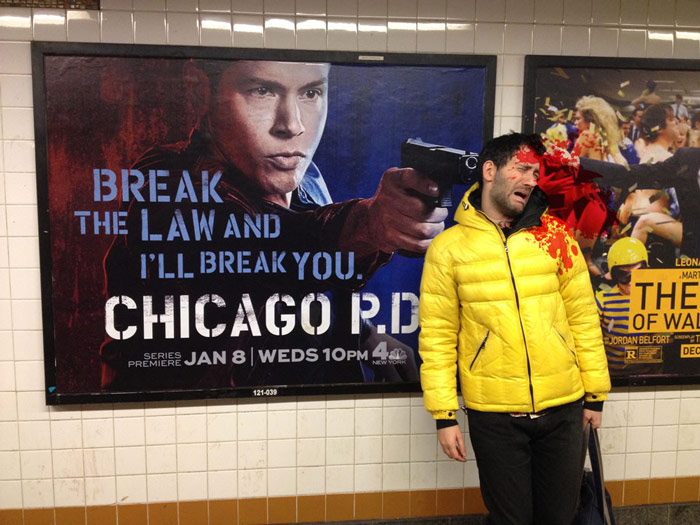
What does a typical day look like for you?
When I was in Nottingham, I worked all the time. My average day was get up, go to the studio, work till about 8pm, walk the 10 minutes home, cook dinner, eat, go back to work, and then go to sleep. I put in really long hours.
I didn’t want to do that in New York. Here, I get up, noodle around my apartment, go to the studio around 10am, work till about 6pm or 7pm, and then I do something; I go to a restaurant, go home and cook, go see a show, go to the theater, hang out with friends. Sometimes when I leave the studio and there is a shitload of work to do, I feel anxious. But you know what? That email will wait until tomorrow morning because, one, I want to live more and, two, it’s important to feed that inspiration, to get away from the screen and see and do stuff. That means I don’t go to the studio on the weekend very often. I used to have no differentiation between weekdays and the weekend; now, the weekend feels different. The weekend is a little kitten, sleeping in my lap. Then, when I go back to work on Monday, I feel like I’ve been somewhere or done something. That has totally energized my work.
I still travel a lot, too. I just came back from a great time in Dublin, and I had a week in London. I’m about to go to Dusseldorf and then I’ll be in Paris. I try to travel less because I want to maximize my New York time.
I think there’s a sweet spot where you’re successful and can pay your bills, shop occasionally at Whole Foods, and go out for dinner and drinks—not living in luxury, but able to afford the things you want to do and own yourself. There’s a point beyond that where you’re so successful that your manager is calling you, your agent is calling you, your publicist has another interview for you, and you’ve got to go on tour. Maybe you start to lose control of your life; you become property that others are trying to control. I don’t want to do that. I covet doing nothing on a Saturday and not being bothered by anyone. It’s that sweet spot that I’m after: work hard, but not too hard; be successful, but not too successful.
Any favorite music right now?
I’m all about sitting around, listening to music; and if I can be drawing something at the same time, then that’s a bonus.
I buy new music almost every week, and I buy directly from the labels or independent online record stores. I preview music and, if I like it, I buy it. I regularly buy music by artists I’ve never heard of or know nothing about, which is the best way to think about music, just judging it on the sounds. I like anything on the Numbers record label, and anything weird or unusual. Recent purchases include EeOo, K-Man, Legowelt, Logos, Guido, Emerald Web, Débruit & Alsarah, DJ Clap, Giganta, and John Wizards.
Sometimes I like to listen to electronic music that feels as if colorful alien robots from the future have made it. When I feel overwhelmed, I listen to it and it takes me to another realm where I can exist outside of myself, without the baggage of guilt and stress that I carry with me everywhere. I can make work, I’m on fire, and I’m not a person—I’m just a pen, a line, a shape, a color. Music takes me beyond myself. In one of his forewords, Kurt Vonnegut wrote that he’s a clumsy, awkward human, but it’s when he swims that he feels beautiful; he’s effortless in the water, and he’s not himself anymore. That’s how I feel when I’m listening to music and working, but don’t realize I’m working, and music is integral to that.
Do you have a favorite movie or TV show?
I don’t have a TV, and I’m the kind of guy who watches shows 10 years after they come out. I love The Simpsons, The Sopranos, The Wire. Thanks to my brother, I watched Twin Peaks a few years ago, and it was unbelievably good up until the second season.
My problem with most shows is that they go on forever, and they’re about dragging on the audience until the ratings dive. I watched True Detective because it was only eight episodes, and then it was done. It was beautifully made, and it was the perfect length. I’ve watched Girls, too; the first season was great, but it’s got progressively worse as it’s gone on. I mainly watch it to see if I recognize anything around my neighborhood; that and the nudity, although I no longer need to see Lena Dunham’s boobs. I think that after watching the third season, I could draw them from mammary—I mean, memory. Sorry. I can’t watch stuff like Game of Thrones, Breaking Bad, and Mad Men—they’re too much for me. I am excited to see the new season of The Trip, which stars Steve Coogan and Rob Brydon and is directed by Michael Winterbottom. I do watch the Super Bowl and I’ll occasionally watch the Oscars, but that’s enough. I can’t take the adverts; they’re so obnoxious.
I do like cartoons, and I’d love to make a feature-length animation. Right now, I’m working on an animated TV show, so watching cartoons like Adventure Time or Regular Show is research—it’s also research to eat pizza whilst doing so. I’m not embarrassed to say that I’m a big fan of Frozen; it’s not perfect, but it’s really good. The Lego Movie was jaw-droppingly amazing, too.
A few days ago, someone said to me that stuff that appeals to adults and children at the same time contains a universal truth. Maybe that’s what I want to make: stuff that appeals to smart adults and smart children. I want to make work with a childlike sensibility, with a playfulness, openness, and honesty that is also enjoyed by adults who have a sense of humor and knowingness.
Your favorite book?
I’ve been hitting my library and trying to catch up on American classics, like American Pastoral, In Cold Blood, and The Great Gatsby. Most recently, though, I’ve been reading theory and behavioral economic books, like Thinking, Fast and Slow by Daniel Kahneman and books by Nassim Nicholas Taleb, like Antifragile, which has lots of fascinating ideas in it. I’m interested in the way our brains work and how we think and make decisions. My younger brother has inspired me to read those kind of books. One day, if we can ever stop squabbling, we’d like to collaborate on some work together based on behavioral economic theories.
What is your favorite food?
Even though my last name is Burgerman, I’m a vegetarian, which amuses a lot of people. Indian food is my favorite and I like New York pizza.
How long have you been a vegetarian?
Over 10 years now. I became a vegetarian for environmental reasons, and it’s healthier and safer. I don’t think it’s wrong to eat meat, but the mass production of meat and not respecting the lives of the animals is abhorrent. When I started to travel a lot, I decided to offset my carbon footprint by not eating any meat, which, eh, I don’t miss. I also gave up fish, which I used to like with chips and mushy peas.
What kind of legacy do you hope to leave?
Hmm, legacy. I don’t really know—maybe that everyone thinks I’m cool and they wish they’d slept with me? Really, though, once you’re dead, you’re dead. If I can inspire someone, or if someone does something good because of me, then that would be great. I’d honestly like to contribute to the general well-being of others, to make people feel better, happier. Apart than that, what else can you do? We’re all just little blips on the screen.
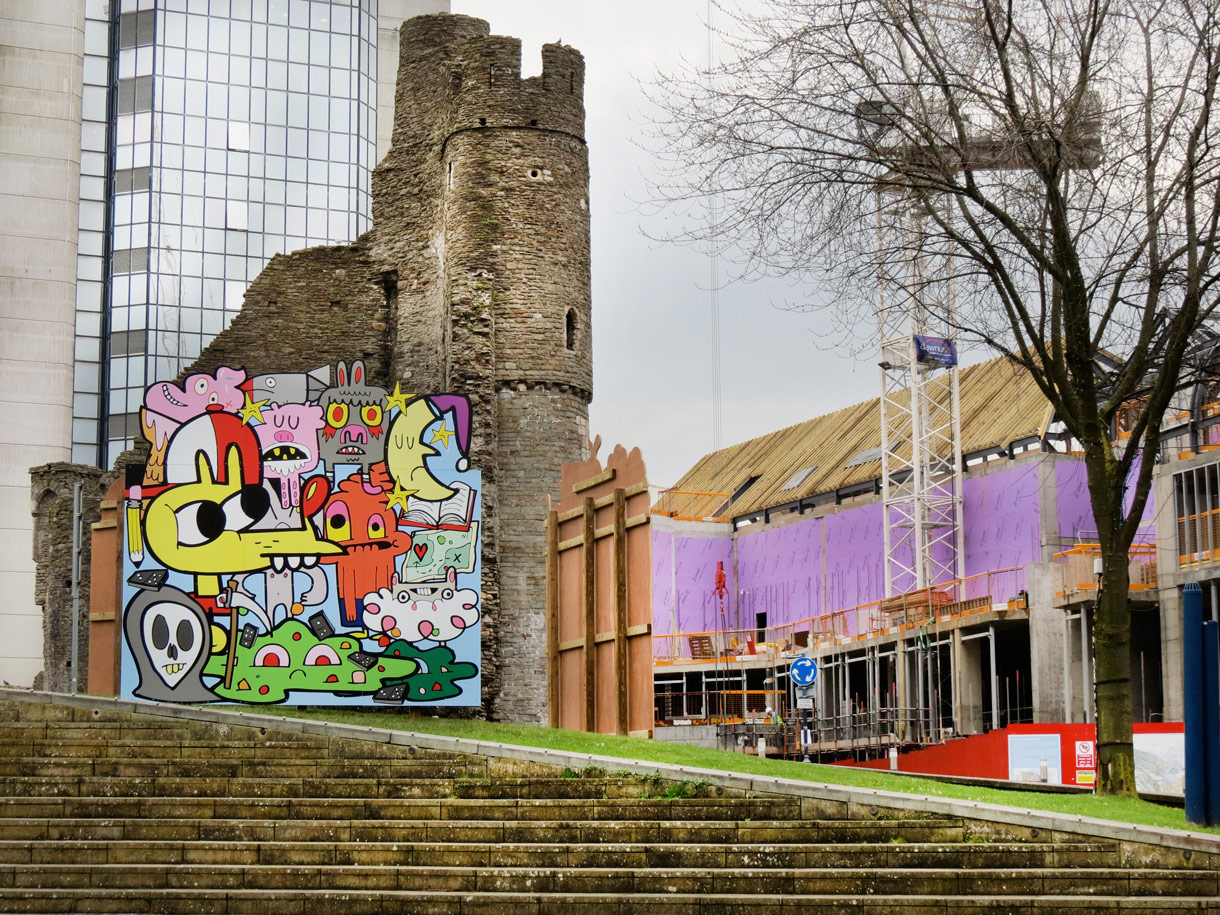
“…people are the conduit to everything. Nothing happens without people. No matter who you are, you need other people. You need to go talk to others, chat with them, laugh with them, have a drink with them. You need to be out there, meeting people, even more so now that our default is digital interaction.”